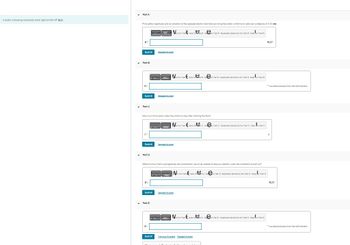
College Physics
11th Edition
ISBN: 9781305952300
Author: Raymond A. Serway, Chris Vuille
Publisher: Cengage Learning
expand_more
expand_more
format_list_bulleted
Concept explainers
Question

Transcribed Image Text:A proton is traveling horizontally to the right at 4.00×10² m/s.
▾ Part A
▾
Find (a)the magnitude and (b) direction of the weakest electric field that can bring the proton uniformly to rest over a distance of 3.10 cm.
E
Submit
Part B
Submit
Part C
Se vora o for Part A Part A keyboard shortcuts for Part A help Part A
redo for
For
Submit
Part D
Submit
▾ Part E
ut Ater
How much time does it take the proton to stop after entering the fold?
ve
Submit
que Ar
Vec
No for Parrado fot
Idequat Arawer
VOCY
N
What minimumfeld ((a)magnitude and (b)direction) would be needed to stop an electron under the conditions of part (a)?
zve
equat Antar
o for Parl redo for Cra
Park &
M
N
or Part 5 keyboard shortcuts for Parts Par
e
a for Par
redu for 10 m
do for Par
Previous Arawers Hequaat Anawer
Part C keyboard shortcuts for Part C help Part C
L
frado femer
........
Part D keyboard shortcuts for Parthelp Part D
ParlE keyboard shortcuts for ParlE por Par E
N/C
*counterclockwise from the left direction
5
N/C
counterclockwise from the left direction
Expert Solution
This question has been solved!
Explore an expertly crafted, step-by-step solution for a thorough understanding of key concepts.
Step by stepSolved in 6 steps

Knowledge Booster
Learn more about
Need a deep-dive on the concept behind this application? Look no further. Learn more about this topic, physics and related others by exploring similar questions and additional content below.Similar questions
- Find the magnitude of the acceleration (in m/s2) for an electron in a uniform electric field with a magnitude of 100 N/C. m/s2 Submit Answer Tries 0/2 Find the time it takes (in sec) for an electron initially at rest in a uniform electric field of 100 N/C to reach a speed of 0.01c (where c is the speed of light).arrow_forwardI Review | Cor Two protons are 7.0 fm apart. ( 1 fm = 1 femtometer = 1 x 10-15 m.) Part A What is the magnitude of the electric force on one proton due to the other proton? Express your answer in newtons. να ΑΣφ ? FE = Submit Request Answer Part B What is the magnitude of the gravitational force on one proton due to the other proton? Express your answer in newtons. nνα ΑΣφ Fc = N Submit Request Answer Part C What is the ratio of the electric force to the gravitational force? 第-| FG Submit Request Answer P Pearsonarrow_forwardBoth questionsarrow_forward
- Number 9arrow_forwardEL3: For the given scenario, draw the electric field lines (not vector arrows, but lines). You may use the Charges and Fields PhET simulation as a resource. Include at least 10 field lines. Identify a location where the force on a positive charge would be up (north). ++ +arrow_forward1. An electron, a proton, an a particle (i.e. the He nucleus consisting of 2 protons and 2 neutrons), and a chlorine ion (CI) are shot into a uniform electric field, perpendicular to the field lines, all with the same speed. а. Sketch the trajectories of the three particles. Show clearly which curvature is the greatest, and which is the smallest. Label, which is which. b. Order the magnitudes of forces acting on the particles – the greatest to the smallest С. Order the accelerations of the particles – the greatest to the smallest E V particlearrow_forward
- Harrow_forwardCHECK YOUR UNDERSTANDING. Solve the following problems below. Show complete solution with the final answer and unit of measurement written inside a box. 1. A point particle of charge 2.5 x 109 C and a mass of 3.65 x 10-7 kg in uniform electric field directed to the right. It is released from rest and moves to the right. It is released from rest and moves to the right. After it has traveled 1.45 m, its speed is 35 m/s. Find, a. work done on the particle b. change in the electric potential energy of the particlearrow_forwardQ2. An electron with speed 18x106 km/h is traveling parallel to an electric field of magnitude 9.5 kN/C. (a) How far will the electron travel before it stops? (b) How much time will elapse before it returns to its starting point? 02 Au in. ofmed...a ioarrow_forward
arrow_back_ios
arrow_forward_ios
Recommended textbooks for you
 College PhysicsPhysicsISBN:9781305952300Author:Raymond A. Serway, Chris VuillePublisher:Cengage Learning
College PhysicsPhysicsISBN:9781305952300Author:Raymond A. Serway, Chris VuillePublisher:Cengage Learning University Physics (14th Edition)PhysicsISBN:9780133969290Author:Hugh D. Young, Roger A. FreedmanPublisher:PEARSON
University Physics (14th Edition)PhysicsISBN:9780133969290Author:Hugh D. Young, Roger A. FreedmanPublisher:PEARSON Introduction To Quantum MechanicsPhysicsISBN:9781107189638Author:Griffiths, David J., Schroeter, Darrell F.Publisher:Cambridge University Press
Introduction To Quantum MechanicsPhysicsISBN:9781107189638Author:Griffiths, David J., Schroeter, Darrell F.Publisher:Cambridge University Press Physics for Scientists and EngineersPhysicsISBN:9781337553278Author:Raymond A. Serway, John W. JewettPublisher:Cengage Learning
Physics for Scientists and EngineersPhysicsISBN:9781337553278Author:Raymond A. Serway, John W. JewettPublisher:Cengage Learning Lecture- Tutorials for Introductory AstronomyPhysicsISBN:9780321820464Author:Edward E. Prather, Tim P. Slater, Jeff P. Adams, Gina BrissendenPublisher:Addison-Wesley
Lecture- Tutorials for Introductory AstronomyPhysicsISBN:9780321820464Author:Edward E. Prather, Tim P. Slater, Jeff P. Adams, Gina BrissendenPublisher:Addison-Wesley College Physics: A Strategic Approach (4th Editio...PhysicsISBN:9780134609034Author:Randall D. Knight (Professor Emeritus), Brian Jones, Stuart FieldPublisher:PEARSON
College Physics: A Strategic Approach (4th Editio...PhysicsISBN:9780134609034Author:Randall D. Knight (Professor Emeritus), Brian Jones, Stuart FieldPublisher:PEARSON

College Physics
Physics
ISBN:9781305952300
Author:Raymond A. Serway, Chris Vuille
Publisher:Cengage Learning

University Physics (14th Edition)
Physics
ISBN:9780133969290
Author:Hugh D. Young, Roger A. Freedman
Publisher:PEARSON

Introduction To Quantum Mechanics
Physics
ISBN:9781107189638
Author:Griffiths, David J., Schroeter, Darrell F.
Publisher:Cambridge University Press

Physics for Scientists and Engineers
Physics
ISBN:9781337553278
Author:Raymond A. Serway, John W. Jewett
Publisher:Cengage Learning

Lecture- Tutorials for Introductory Astronomy
Physics
ISBN:9780321820464
Author:Edward E. Prather, Tim P. Slater, Jeff P. Adams, Gina Brissenden
Publisher:Addison-Wesley

College Physics: A Strategic Approach (4th Editio...
Physics
ISBN:9780134609034
Author:Randall D. Knight (Professor Emeritus), Brian Jones, Stuart Field
Publisher:PEARSON